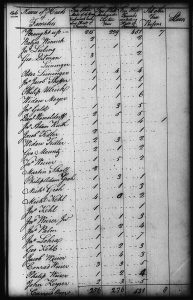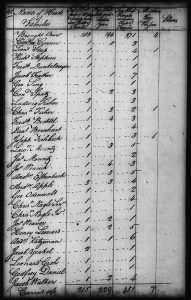Jeffrey Groah
Dr Jeff Groah's SiteHistorical Documents 2
How did the Groahs get to America and when? I cannot answer these questions with certainty, but there are clues.
First, the 1790 Census was the first Census of the United States and there we may find Philip Adam Groh in Berks County, Pennsylvania.
Of note, there is one adult male, one adult female and three minor male children under the age of sixteen. These must be Philip’s sons Daniel, John and George. William was born after 1790, as was his twin Katy. Philip’s wife, Mary Magdalena Kael Groah, died in 1850 at the age of 81, implying that she was born in the 1768-1769 time range. If Mary married and started having children at the age of 18, she would have had plenty of time to produce three offspring by 1790. Mary’s record of death in May of 1850 may be found in the Augusta County Mortality Census.
Next door to Philip was Nicholas Groh. Who this was is a mystery to me as this is the only record I could uncover of him. He was likely a brother, similar in age to Philip. On his property there is One adult male, one young male and three females. He likely lived with his wife, son and two daughters.
Down the page you will find the names of Michael Kehl, John Kehl and George Kehl. Mary’s father was (Johann) Michael Kehl (b. 1734 in Penn) and he is shown on this Census to have on his farm four adult free males and two females. This is consistent with an older man having older children on the farm as well as his wife, but no young children. Almost all of Michael’s male children were given the first name “John”. There is John Jacob, John Michael, John George, John Peter, and then there’s Leonard. This was common in German families. For females, Germans often gave their daughters a common first name like Anna or Mary (Maria/Marie). They also often used different versions of their names depending of whether they were in company of Germans of English speakers. What may be Maria Magdalena on a church birth record might be Mary Magdalene in English speaking company.
George (b. 1760 m. 1782) is shown on the Census to have on his farm one adult male, two young males and three females. The John Kehl could be any number of Michael’s children.
Kehl vs. Kael. In the St. John’s Church Register in Middlebrook, Virginia, you may find: Kehl, Kahl, Cale, Cales, etc. There seems not to have been any fixed spelling. What is more, there was an Anglicization going on concerning names. What was in French “Somers” became “Summers”.
One of the most important clues concerning the arrival of the Groahs on the American continent comes not on this page of the census but the previous page.
You find here the name Leonard Groh, and on his farm is only one adult male and one female. This is consistent with and older male and female living alone. (It could also be a newly married couple.) This is likely Philip Adam Groh’s father and mother.
Concerning the arrival of the Groah family on the North American Continent in the 18th century, there is a source titled Names of Foreigners Who Took the Oath of Allegiance In the Province And State of Pennsylvania, 1727 – 1775, With Foreign Arrivals 1786-1808. Edited By William Henry Egle, M. D.
On p. 316, Johann Leonhard Groh is listed as a passenger on Brothers having arrived on August 24, 1750.
The only source that I have of Philip Adam Groh’s birth is: [Heads of Fams. at the first U.S. census. Pa. By U.S. Bureau of the Census. Washington, 1908. (426p.):35 Ten “Series” of “Pennsylvnia Archives” have been so far published in from 5 to 31v. Ea. Philadelphia and Harrisburg. 1852- ( We have indexed Series 2, v.2 and v.8 ( early Pa. marriage recds.) And all the v. of SeriesV. Which contain nearly complete Pa. Rev. War recds.)Ser.5. 5:242.]
This source gives Philip’s birth year as 1750 but all Grohs in this reference also give 1750 as the birth year. It seems that this reference is only able to give the decade of their births. All I can deduce is that Philip Adam Groh was born in Pennsylvania sometime between 1750 and 1759. If you can find church records from the area, please let me know.
Philip Adam Groh served in the Berks County Militia during the American Revolution.
Philip Adam Groah died on 18 Sept, 1824. His will and estate sale inventory is given at https://www.familysearch.org/tree/person/memories/L7LK-SNZ.
Philip Groah’s will says, as transcribed by me:
In the name of God, Amen, I, Philip Groah of Augusta County and State of Virginia, being weak in body by reason of sickness but sound of mind, memory and of judgment, blessed by God, and calling to mind the mortality of body that is for all men’s bodies, do this second day of June in the year of our Lord one thousand eight hundred twenty-four make, ordain and publish this, my last will and testament in manner and form as follows.
I resign up my soul to God who gave it and my body to be buried at the discretion of my executors, nothing doubting but at the last day both will be united in Glory and respecting that part of the good things of this world which it hath pleased God to bless me with, I bequeath and dispose of as follows, Amen.
I bequeath unto my son, William Groah, my plantation to be his, his heirs or assigns, forever at my death by him giving my wife, Mary Groah, twelve bushels of wheat and ten bushels of corn each year during her lifetime, beside ten pounds of coffee and one hundred pounds of pork, and a half bushel of flax sowed each year, and give her a cow and furnish my wife a comfortable house on the plantation to live in her lifetime.
I bequeath unto my son, John Groah, forty dollars to be paid to him by my son, William, one year after my death.
I bequeath unto my grandchildren by my son, George Groah, three children, twenty dollars each to be paid to them by son William as they come of age.
I bequeath unto my daughter, Caty Luntzford, forty acres of land on which she now lives her lifetime, and at her death for it to be sold and equally divided among her children.
I bequeath unto my grandson, Joseph, after my wife’s death, all my household furniture and the cow that William is to give my wife.
I do hereby constitute and appoint my son, William Groah, sole executor of all my estate.
I do hereby disannul and revoke all other wills and testaments by me here-to-fore made and do ratify, establish and proclaim this my last will and testament.
In witness thereof, I, Philip Groah, have hereunto set my hand and seal, the day and year above written.
Philip Groah
Signed, sealed, published and acknowledged by Philip Groah as his last will and testament in the presence of us who were present at the signing, sealing and acknowledging of the same: James Lockridge John Steele, Jr. David Zink
It is also interesting to note that all four of Philip’s sons served in the Virginia Militia during the War of 1812. I found service records at the National Archives for Daniel, John, George and William, one after the other. Since William’s sons Andrew Jackson and Samuel Kael served on both sides of the American Civil War, we have represented here three generations of American veterans.
When did Philip Groh/Groah relocate to the Shanandoah Valley in Virginia? There is nothing definitive here but family lore is that he left in 1798 when his son William was five-years-old. They likely left after the death of Philip’s parents.




